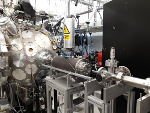| | 27 | |
| | 28 | Present: SG, OE, AK, JPa, RT, LM, KL, JPo, |
| | 29 | |
| | 30 | 1. Introduction: **//KL//** |
| | 31 | * KL expressed regret that it had not been possible to find a scope that satisfied the ERC Adv Grant constraints. Recognising the hard work that had gone into the development of the design so far, this was a disappointment. However, it seemed that there was a concensus that the devision was reasonable. |
| | 32 | 1. Updates on development of systems: **//All//** |
| | 33 | * LM: Working towards simultion of end-station to estimated dose to cells. Cell layer is between 14-30 microns thick. BDSim is not yet interfaced to most accurate low-energy simulation of particle-tissue interactions. Will use the presently-interfaced codes for now. Vacuum window thickness will be provided by JPo: Assume 1cm2 apperture, so window thickness should be a few 10s of microns of some nitride material. |
| | 34 | 1. Effect of space charge: **//JPo//** |
| | 35 | * Simulation of beam transport from interaction region of laser to 3-4 m from source. Runs were made with 0 space charge and then 5*10^9, 5*10^10 and 5*10^10 particles per shot. 100 fs duration, width of the angular distribution as in the file from OE. Assumed flat top distribution. |
| | 36 | * Co-propagating charges, so, no space-charge effect at source. Now think that as soon asbeam is larger than 1mm, there is no significant space-charge effect. Blow up of beam at source so fast that space charge looks like it is not an issue d/s of the target. |
| | 37 | 1. Compactifying the lattice: **//JPa//** |
| | 38 | * See slides. |
| | 39 | 1. AoB: |
| | 40 | * JPa: has made an initial study of the next acceleration stage. A spiral FFA ... injection at 8.6, acceleration to 75 MeV (protons). Requires 10 magnets; 3.1M radius. Resonator requires swing between 1MHz and 10MHz. A double spiral scheme has been adopted to accomodate ISIS u/g design. ISIS will consider ferite, rather than MA, cavity. Need to make case with them in RF meeting in beginning of September 2018. |
| | 41 | * We agreed we need to consider ion acceleration and agree to focus on: proton, He, Li, carbon, and oxygen |
